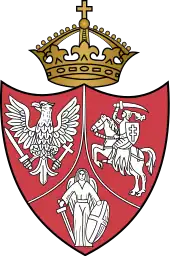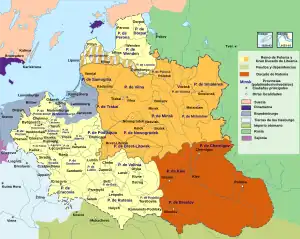Polish–Lithuanian–Ruthenian Commonwealth Rzeczpospolita Trojga Narodów (Polish) Trijų Tautų Respublika (Lithuanian Річ Посполита Трьох Народів (Ukrainian) Res Publica (Latin) | |||||||||||||
|---|---|---|---|---|---|---|---|---|---|---|---|---|---|
| 1658–1659 | |||||||||||||
 Coat of arms
| |||||||||||||
| Motto: "Si Deus nobiscum quis contra nos" "Pro Fide, Lege et Rege" "If God is with us, then who is against us" "For Faith, Law and King" | |||||||||||||
.png.webp) Location of Polish-Lithuanian-Ruthenian Commonwealth | |||||||||||||
| Status | Proposed state | ||||||||||||
| Capital | Warsaw Vilnius Kyiv | ||||||||||||
| Official languages | Polish, Latin, Ruthenian | ||||||||||||
| Religion | Catholicism | ||||||||||||
| Demonym(s) | Polish, Lithuanian, Ruthenian | ||||||||||||
| Government | Constitutional monarchy | ||||||||||||
| History | |||||||||||||
| 1658 | |||||||||||||
• Dissolved | 1659 | ||||||||||||
| |||||||||||||
The Polish–Lithuanian–Ruthenian Commonwealth (Polish: Rzeczpospolita Trojga Narodów, lit. 'Republic of Three Nations', Lithuanian: Trijų Tautų Respublika, Ukrainian: Річ Посполита Трьох Народів) was a proposed European state in the 17th century that would have replaced the existing Polish–Lithuanian Commonwealth, but it was never actually formed.
A way to establishment a Grand Duchy of Ruthenia was considered by the Ukrainian hetman Bohdan Khmelnytsky at various times,[1] particularly during the 1648 Cossack insurrection, against Polish rule in the primarily-ethnically Ukrainian territories (see Khmelnytsky Uprising). Such a Ruthenian duchy, as proposed in the 1658 Treaty of Hadiach, would have been a full-fledged member of the Polish–Lithuanian Commonwealth, which would thereby have become a tripartite Polish–Lithuanian–Ruthenian Commonwealth. In May 1659, the Polish Diet (Sejm) ratified the treaty with an amended text.[2] The plan, as envisioned by Yuri Nemyrych, would have ennobled a portion of the Cossacks, which would then run the Grand Principality of Ruthenia (1658). Hetman Ivan Vyhovsky could not get enough Cossacks agree to keeping the Uniate Church, which the Catholic church refused to liquidate, but many Cossacks were strongly against the idea.[3]
The plan meant an annulment of the Pereiaslav Agreement's arrangements and as such renewed hostilities between the Commonwealth and the Tsardom of Russia.[1]
The idea of a Ruthenian Duchy within the Commonwealth was completely abandoned in 1659 after the second Agreement.[1][4] The Canadian historian Paul Robert Magosci believes that happened because of the divisions among the Cossacks and because of the Russian invasion.[5] However, those events were much earlier than the signing of the Treaty of Hadiach. The Russian historian Tairova-Yakovleva regards the resistance of Polish society and papal pressure as the reasons for the failure in ratification.
The idea of a Polish–Lithuanian–Ruthenian Commonwealth revived during the January Uprising when a patriotic demonstration took place at Horodło in 1861. The so-called Second Union of Horodło was announced there by the szlachta of Congress Poland of the former Grand Duchy of Lithuania of Volhynia and of Podolia. The New Commonwealth, based on the Second Union of Horodło, was to be based on the three nations, and its proposed coat of arms included the Polish eagle, the Lithuanian Pahonia, and the patron saint of Ruthenia, the Archangel Michael.
Treaty of Hadiach

The Treaty of Hadiach (Polish: ugoda hadziacka, Ukrainian: гадяцький договір) was a treaty signed on 16 September 1658 in Hadiach between the representatives of the Polish–Lithuanian Commonwealth and the Cossack Hetmanate. Its main goal was to create an equal position of Poles, Lithuanians and Ruthenians through the creation of the Polish–Lithuanian–Ruthenian Commonwealth, a country of three nations.[6]
This decision, however, divided the Ukrainian Cossacks into pro-Russian and pro-Polish parties and led to the Ruin (Ukrainian history).
The concept of reconciliation between the Cossack Hetmanate and the Polish–Lithuanian Commonwealth was based on the principle of the confederal system of the Polish-Lithuanian Commonwealth implemented at the Lublin Sejm in 1569.
According to the conditions proposed by the hetman Vyhovsky, Ukraine as an independent state called the Grand Duchy of Ruthenia was to join the confederation on equal terms with Poland and Lithuania. The territory of the Grand Duchy of Ruthenia consisted of the Kyiv, Bratslav and Chernihiv Voivodeships. The highest legislative power belonged to the national assembly of deputies, who were elected from all lands of the principality. Executive power was exercised by the hetman, who was elected for life and approved by the king. The selection of candidates for hetman was to be carried out jointly by all levels of Ukrainian society — the Cossacks, the nobility, and the clergy. The hetman headed the armed forces of Ukraine. In the Grand Duchy of Ruthenia, the state positions of chancellor, marshal, sub-treasury and the highest judicial tribunal were established.[7]
All paperwork was to be conducted in the Ruthenian language. In Kyiv or in another city, it was supposed to create a mint for minting one's own coin.
The Ukrainian army was to consist of 30,000 Cossacks and 10,000 troops hired by the hetman. The troops of the Polish–Lithuanian Commonwealth were forbidden to stay on the territory of the principality. In the event of hostilities in Ukraine, the troops of the Polish–Lithuanian Commonwealth, which were on its territory, came under the command of the hetman. The rights and privileges of Cossacks were guaranteed. At the request of the hetman, one hundred Cossacks from each regiment were to be admitted to the nobility every year.
Orthodox believers were equal in rights with Catholics. The Greek Catholic Church was preserved, but could not spread to new territories. The Orthodox Metropolitan of Kyiv and five Orthodox bishops were to be given the right to sit in the common senate of the Commonwealth.[8]
The agreement provided for the consolidation of the academic status of the Kyiv–Mohyla Academy and equalization of its rights with the University of Kraków. On the territory of the principality, it was planned to establish another Orthodox academy and secondary educational institutions — collegiums, as well as to fund the required number of primary schools and printing houses.[9]
Generally speaking, the treaty was unsuccessful. From the point of view of the politics of the Cossack Hetmanate, the terms of the treaty drafted by the Sejm of the Polish–Lithuanian Commonwealth were a step back compared to the terms offered to the Cossacks by Moscow four years ago. Instead of a de facto independent state under the protection of a foreign ruler, the Cossack state, now called the Duchy of Ruthenia, became a component of the Polish–Lithuanian Commonwealth, integrated into its administrative and territorial system. Its territory was divided into three voivodeships. The hetman had no right to diplomatic relations with foreign rulers. The Ukrainian Cossack army was reduced from 60 to 30 thousand. The Cossacks lost the right to elect the hetman, which now passed to the foreman. Moreover, the granting of nobility to a limited circle of Cossack elders deprived the common Cossacks of their own elite. Such conditions were significantly inferior to the proposed and largely implemented conditions of the Treaty of Pereiaslav in 1654.
After the Russo–Polish War (1654–1667), Ukraine was divided into the Right Bank, which remained part of the Polish-Lithuanian Commonwealth until its Second Partition in 1793, and the Left Bank, which, together with Kyiv on the Right Bank, became part of the Tsardom of Russia.[10]
See also
References
- 1 2 3 "Unia hadziacka i marzenia o stworzeniu Rzeczpospolitej Trojga Narodów". Polskie Radio (in Polish). 16 September 2023. Retrieved 19 November 2023.
- ↑ Władysław Konopczyński (1936). Dzieje Polski nowożytnej (A History of Modern Poland. Second edition, Warsaw 1986, p.27). ISBN 83-211-0730-3 : W izbach dużo było narzekania na to, że nowy układ łamie unię lubelską (...) Ostatecznie nad tymi rozczeniami, jak i nad protestem nuncjusza [Piotra Vidoniego] oraz biskupów, sejm przeszedł do porządku dziennego. 12 maja, w dzień Wniebowstąpienia, król, prymas i senat zaprzysięgli ugodę.
- ↑ Snyder, Timothy (2004-07-11). The Reconstruction of Nations: Poland, Ukraine, Lithuania, Belarus, 1569-1999. Yale University Press. p. 115. ISBN 978-0-300-10586-5.
- ↑ Т.Г. Таирова-Яковлева, Иван Выговский // Единорогъ. Материалы по военной истории Восточной Европы эпохи Средних веков и Раннего Нового времени, вып.1, М., 2009: Под влиянием польской общественности и сильного диктата Ватикана сейм в мае 1659 г. принял Гадячский договор в более чем урезанном виде. Идея Княжества Руського вообще была уничтожена, равно как и положение о сохранении союза с Москвой. Отменялась и ликвидация унии, равно как и целый ряд других позитивных статей.
- ↑ Paul Robert Magocsi (1996). A History of Ukraine. Toronto: University of Toronto Press, pp.221-225. ISBN 0-8020-0830-5
- ↑ The 1658 treaty of Hadiach (Гадяцький договір 1658 року). Ukrayinskyi istoryk.
- ↑ The 1658 treaty of Hadiach (Гадяцький договір 1658 року). Ukrayinskyi istoryk.
- ↑ The 1658 treaty of Hadiach (Гадяцький договір 1658 року). Ukrayinskyi istoryk.
- ↑ The 1658 treaty of Hadiach (Гадяцький договір 1658 року). Ukrayinskyi istoryk.
- ↑ Frost, Robert I (2000). The Northern Wars. War, State and Society in Northeastern Europe 1558–1721. Longman. p. 13. ISBN 978-0-582-06429-4.
.svg.png.webp)